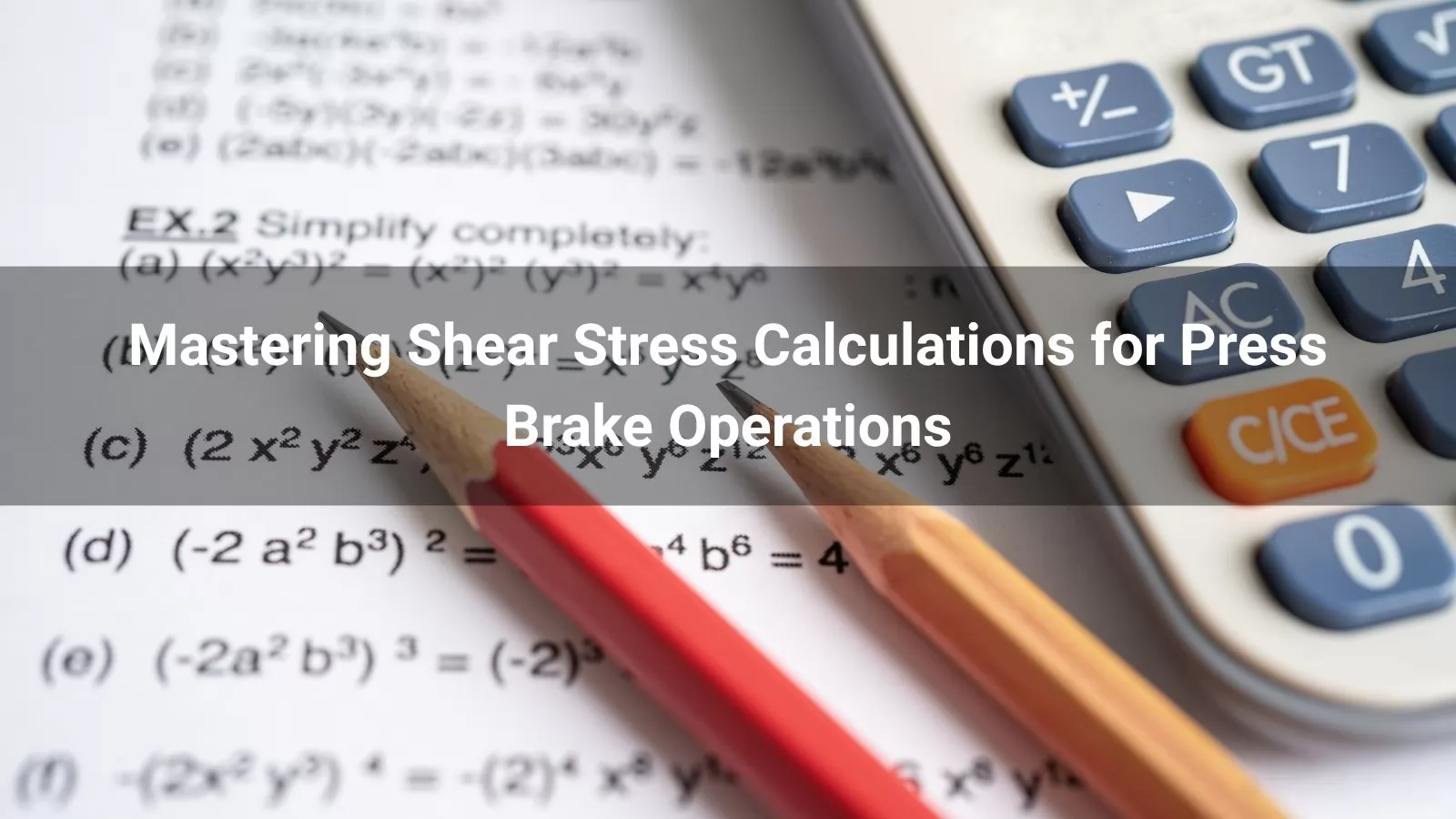




Shear stress is a fundamental concept in engineering and material science, particularly relevant to press brake operations where sheet metal is bent into precise shapes. Shear stress, denoted as τ, measures the force per unit area acting tangentially to a material’s surface, causing it to slide or deform. In press brake applications, shear stress arises when metal is bent, as the material experiences forces that can lead to slipping, tearing, or buckling if not properly managed. Understanding shear stress ensures that components produced by press brakes meet structural integrity and performance requirements.
This guide explains how to use a Shear Stress Calculator to analyze and optimize press brake operations, provides detailed material data, and offers practical examples tailored to industries like automotive (e.g., chassis parts), aerospace (e.g., structural components), and construction (e.g., beams). With insights from Shinite, a leading China press brake manufacturer, we’ll explore how advanced press brake technology enhances shear stress management.

Shear stress occurs when forces act parallel to a material’s surface, unlike normal stress, which acts perpendicularly. In press brake bending, shear stress is critical because it determines whether the metal will deform correctly or fail under the applied force. Key failure modes include:
Slipping: Layers of the material slide past each other.
Tearing: The material fractures due to excessive shear stress.
Buckling: The material collapses under compressive and shear forces.
To manage these risks, engineers must calculate shear stress accurately and compare it to the material’s shear strength, ensuring a sufficient safety factor.
For a simple rectangular beam or sheet metal subjected to a shear force V, the shear stress is calculated as:
τ = V / A
Where:
τ: Shear stress (Pa or N/m²)
V: Shear force (N)
A: Cross-sectional area (m²)
However, press brake operations often involve complex geometries and loading conditions, requiring advanced calculations and tools like Shear Stress Calculators.
Accurate shear stress calculations depend on understanding the material properties of the metal being bent. Below is an expanded table of properties for common metals used in press brake operations, including additional alloys relevant to Shinite’s applications.
Table 1: Shear Stress Data for Common Metals
|
Metal |
Shear Modulus (G) |
Shear Strength (τ_max) |
Density (ρ) |
Poisson’s Ratio (ν) |
|---|---|---|---|---|
|
Steel (A36) |
80 GPa |
250 MPa |
7850 kg/m³ |
0.30 |
|
Stainless Steel (304) |
77 GPa |
320–380 MPa |
8000 kg/m³ |
0.29 |
|
Aluminum (6061) |
27 GPa |
90 MPa |
2700 kg/m³ |
0.33 |
|
Copper |
48 GPa |
120 MPa |
8960 kg/m³ |
0.34 |
|
Brass |
35 GPa |
150 MPa |
8500 kg/m³ |
0.35 |
|
Titanium (Grade 5) |
44 GPa |
240 MPa |
4510 kg/m³ |
0.34 |
|
High-Strength Steel (Q235) |
79 GPa |
141–188 MPa |
7850 kg/m³ |
0.30 |
Source: Adapted from ASTM standards and MachineMFG data
These properties—shear modulus (G), shear strength (τ_max), density (ρ), and Poisson’s ratio (ν)—are critical inputs for Shear Stress Calculators and influence how materials behave under press brake forces.
A Shear Stress Calculator is a powerful tool that simplifies the analysis of shear stress in press brake bending. It accounts for material properties, geometry, and loading conditions to provide accurate stress values. Here’s a step-by-step guide to using it effectively:
Input Material Properties:
Select the metal (e.g., Steel A36, Aluminum 6061) and enter its shear modulus, shear strength, density, and Poisson’s ratio from Table 1.
For example, for Stainless Steel (304), input G = 77 GPa, τ_max = 320–380 MPa, ρ = 8000 kg/m³, ν = 0.29.
Define Geometry:
Specify the sheet metal’s dimensions (width, thickness, length) and the bend configuration (e.g., V-bend, U-bend).
Example: A sheet of 0.3 m width, 0.005 m thickness, and 2 m length.
Apply Loading Conditions:
Enter the shear force applied by the press brake’s punch, which depends on the machine’s tonnage and the material’s thickness.
Example: A Shinite CNC press brake applies a shear force of 150 kN.
Calculate Shear Stress:
The calculator computes the shear stress distribution, identifying the maximum shear stress (τ_max) and its location.
For complex bends, advanced calculators may account for non-uniform stress distribution using equations like τ = VQ / (I × t), where Q is the first moment of area, I is the moment of inertia, and t is the thickness.
Interpret Results:
Maximum Shear Stress: Compare τ_max to the material’s shear strength to assess failure risk.
Stress Distribution: Visualize high-stress zones to optimize tooling or material selection.
Safety Factor: Calculate as SF = τ_max (material) / τ_max (calculated). A factor >1 indicates safety.
In press brake operations, shear stress varies across the bend due to factors like:
Bend Radius: Tighter radii increase shear stress concentration.
Tooling Design: Shinite’s precision tooling minimizes stress concentrations.
Material Anisotropy: Some metals (e.g., titanium) exhibit directional properties, affecting shear behavior.
Modern CNC press brakes, like those from Shinite, integrate sensors and software to monitor real-time stress, ensuring optimal bending parameters.
Shear stress calculations are vital for press brake applications across industries:
Automotive: Forming chassis components or body panels requires precise shear stress analysis to prevent cracking.
Aerospace: Lightweight alloys like titanium demand careful stress management to maintain structural integrity.
Construction: Bending steel beams or plates for structural supports relies on shear stress data to ensure stability.
Manufacturing: Producing enclosures or brackets involves optimizing shear stress for durability and cost-efficiency.
Shinite’s press brakes, equipped with advanced CNC controls, enhance these applications by providing precise force application and real-time stress monitoring.
Consider a Shinite press brake bending a Stainless Steel (304) sheet for an aerospace component:
Dimensions: Width = 0.4 m, Thickness = 0.004 m, Length = 3 m.
Shear Force: 180 kN (applied by Shinite CNC press brake).
Cross-sectional Area: A = 0.4 m × 0.004 m = 0.0016 m².
Using the shear stress formula:
τ = V / A = 180,000 N / 0.0016 m² = 112.5 MPa
Comparing to the shear strength of Stainless Steel (304) (320–380 MPa):
SF = 320 MPa / 112.5 MPa = 2.84
The safety factor of 2.84 indicates the bend is safe, with room for additional loading. A Shinite CNC press brake’s precision ensures uniform force distribution, minimizing stress concentrations.
For a V-bend, shear stress varies across the thickness. Using the formula τ = VQ / (I × t):
Q: First moment of area (calculated based on neutral axis position).
I: Moment of inertia for the sheet’s cross-section.
t: Thickness (0.004 m).
A Shear Stress Calculator simplifies this, providing stress contours to identify high-risk zones, which Shinite’s machines can mitigate through optimized tooling.
Shinite, a leading China press brake manufacturer, enhances shear stress management through:
Advanced CNC Systems: Precise control of force and bend angle reduces stress concentrations.
Durable Tooling: High-quality punches and dies withstand high shear forces, extending machine life.
Custom Solutions: Tailored configurations for specific materials and geometries.
Sustainability: Energy-efficient designs lower operational costs and environmental impact.
These features make Shinite press brakes ideal for managing shear stress in demanding applications.
While Shear Stress Calculators are powerful, consider:
Non-Uniform Stress: Simple formulas assume uniform stress, but real-world bending involves variations.
Material Variability: Heat treatment or impurities can alter shear strength (e.g., Q235 steel: 141–188 MPa).
Operator Skill: Proper setup of Shinite’s CNC press brakes requires training to optimize stress distribution.
A Shear Stress Calculator is an essential tool for press brake operations, ensuring safe and efficient bending of metals like steel, aluminum, and titanium. By inputting material properties, geometry, and loading conditions, engineers can predict and manage shear stress, preventing failures like slipping or tearing. Shinite’s advanced CNC press brakes enhance this process with precision, durability, and real-time monitoring, making them a top choice for manufacturers in China and beyond.
For tailored solutions or to explore Shinite’s press brake offerings, contact their team or visit their website. Master shear stress calculations to unlock the full potential of your press brake operations.





Fastest
Installation

Top-Notch
Equipment

24/7 Customer
Support

100% Secured
Payment
